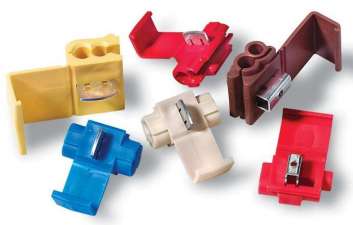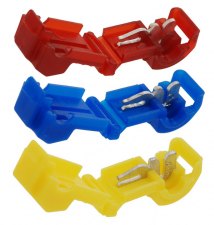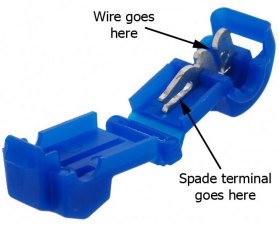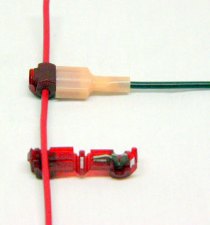The Problem with Wire-Tap Connectors
Posted by Bare | Last Updated August 22, 2013| Inline wire taps |
| T-tap connectors |
| T-tap connector details |
| T-tap connectors |
Many electrical accessories today come with connectors that are designed to “splice” connections into other wires without the need for cutting and soldering. 3M™ makes a lot of these under the Scotchlok™ name in all sorts of sizes and for all types of uses (see pics to the right). These connectors are commonly referred to as “vampire connectors” because they “bite” into another wire to “suck” power.
The different colors indicate the size (gauge) of the wire they are designed to work on. In some cases these connectors can be useful and save a lot of time, but the types and sizes that are typically used for automotive and motorcycle applications (typically 18-22 gauge) can cause a number of problems up to and including complete failure of the splice.
Inline wire taps (like the top picture) work by placing the connector around an existing wire and then feeding the clean cut end of another wire into it. When the metal portion is pressed down with a pair of pliers it cuts like a small guillotine into both wires and establishes a connection across the 2 wires in the process. The little plastic strap folds over and clips in place to hold the metal bit in place.
The other style commonly used in automotive and motorcycle applications is the T-tap (see pics to right). The T-tap accomplishes the same thing as the inline splice but it only cuts it’s way into one wire, the second wire that is “tapping” into it plugs in via a common spade style connector. If you look at the 2 bottom pictures you can get an idea of what I’m talking about.
Now you might wonder what the problem with this is, what makes this so bad? I mean, it’s a quick and easy solution to splicing wires, and it helps those without much electrical skill to add accessories, right? While all this is true, the problems come from a handful of different issues that arise from the nature of the connection itself.
First, the simple act of pressing the wire into this slotted metal piece bludgeons the wire. The concept behind this is fine – it’s supposed to strip back the insulation on the wire to make contact with the wire itself. The problem is that there is no guarantee that you won’t accidentally catch some of the wire in this process and tear some of the individual wire strands. It is actually quite common that this does happen. Second, when the connection process does strip the insulation without completely trashing the wire then the opposite is sometimes true – it only makes limited contact with the wire.
Both the over and under “stripped” problems I mentioned above are often exacerbated by users who do not realize the color/sizing relationship of these connectors to the wires. If you choose a size too big or a size too small for the wire you’re tapping into then you will end up with an exaggerated version of the 2 problems I discuss above. I speak about this with experience because when I was younger I made these exact mistakes!
Now, let’s just say hypothetically that you do establish a perfect connection during the process of installing one of these taps – what then? This is where you have to be concerned about the long-term, surprise you one day/night, maybe leave you stuck on the side of the road, kind of problems. The process of making these connections tears the insulation and leaves some of the wire exposed. Over time the exposed wire begins to oxidize and corrode due to exposure to the elements. All these factors slowly wear on the wire and make it less conductive, but more important to this discussion – the wire becomes brittle.
So now you have an exposed, oxidized, corroded, and brittle wire clamped in the groove of a little metal piece with sharp edges specifically designed for cutting through the wire insulation. Take this situation and add vibration – the kind of vibration you get from just driving your car or bike – motor vibes and bumpy roads. With these elements in place, all that becomes necessary is the last one at play – time…
Brittle wires, sharp edges, regular vibration and time breaks the wire down one strand at a time until complete failure occurs – and remember that this was a “perfect” connection. Splices that cut and nick wires (like I originally mentioned above) will fail faster. Now I understand having your GPS, radio, CB, lightbar or other superficial accessory fail may not be a problem – but the failure of the wires they attach to is. The nature of these taps is that the wire running your accessory is probably going to be OK, but the wire it taps into for power will probably break. This is a problem because, for convenience, most accessories tap into power sources that come on automatically when the key is turned on. What is so important that it comes on and stays on when you turn the key on your bike?
- Computers that control everything from sensors to ignition systems
- Power Commander units (EFI)
- Headlights
- Taillights
- Dash lights
- Radiator fans
So think about your accessories – which 12V wire is going to fail on your bike?
These taps are also commonly used in many other applications such as – load equalizers, Power Commanders, run/turn/brake units – all sorts of things. Not all of these parts would leave you stranded if they were to fail, but some might. Some Power Commander units use a T-tap to splice into the throttle position sensor (TPS) wire and I have seen times where the tap cuts the wire and causes the bike to run horribly until it’s fixed. The slow breaking of the wire as the tap gradually cuts through individual strands can even give you the false appearance that the connection is fine even when it is not.
So consider all these factors and applications and then ask yourself if maybe a little extra time and a soldering iron aren’t in your future. I have never found a wire that I could not splice into with a soldering iron and solder, and I have never experienced a failure of any solder joint I have made. I will admit that I grew up soldering (my dad is an electrical engineer) so I have experience soldering and it’s second nature to me – if you’re intimidated then spend a little time Googling the process. There are a lot of good articles out there discussing the process and explaining the steps in detail. After a little reading, buy yourself a soldering iron and spend some time practicing with some scrap wire until you’re comfortable with it. You’ll quickly learn that the process isn’t terribly complicated and the next time you think about using a tap connector you can do this instead.





Friends don’t Friends use Vampire clips
Great article. I have been an avid promoter of soldering and heatshrinking. Thanks for the smart information.
Excellent advice. I did the Rostra Cruise install with these wire tap connectors. Ended up soldering every joint. A couple of wire taps actually cut through the wiring harness and after hours of tracing I just redid the entire install.
[…] an article detailing the problems with these wire taps/vampire clips. The Problem with Wire-Tap Connectors Bareass Choppers Tech Pages Solder and heat shrink your connections – you won't be sorry. […]
Vamp connectors should be banned, but there is another alternative easier than the solder and heat shrink. Its Posi-Lock connectors. We love them and they are reusable! http://www.posi-lock.com/
I use the Posi-Tap also. It’s just a better design, with very little risk to the integrity of the original wire.
Can’t argue with the superiority of a soldered connection and shrink wrap. This is what I did for my motorcycle license plate light. It was quicker than running down to Autozone for T-taps. If that license plate light is out you are getting stopped. Was considering the T-taps for tail/brake and turns on a motorcycle trunk so they would work in unison with existing lights. You talked me out of it, thank you. I already knew better but considered it anyway. I will be soldering!
The problem with soldering connections is thus: in an automotive, aircraft, or motorcycle or any application subject to vibration you will have work hardening and failure of the solder joint. Vampire taps such as the ones you have discussed are not a very good solution. All the scenarios you have stated are correct. I have just found Posi-Tap and they appear to be a very good solution. Tapping into small automotive applications and soldering a tap and shrinking is a lot of fine work.
This is a very fine discussion you have started.
You are 100% incorrect with your soldering information. I work on aircraft for a living and am 2M qualified. I have no idea where you came up with the vibration causing “work hardening and failure of the solder joint” but it has been used on aircraft wiring (not to mention every circuit card in an aircraft) probably since soldering was started. Soldering would definitely be a preferred method but not the only option in most applications.
Still working in avionics and I once believed as you did, that nothing would match the superiority of a soldered connection.
I have witnessed hundreds of failures of wires at factory-soldered joints, since then, but have not yet witnessed one failure of an enviro-splice. The wire does indeed become stiff at the solder joint, and with years of flexion, even slightly, it will break.
You can combat this, to a degree, with proper engineering of your strain relief and good wire routing, but you’d do better still to do these things and use an appropriate crimp connection.
[…]Interesting, I just did a google search and found this[…]
[…]I am not aware of any T-Tap splices that are worth using. Everything that I have tried out there I cannot recommend anyone using on their vehicles as you are bound to have electrical connection problems later if you use those T tap splices.[…]
[…]although personally i advise against tapping into wires. It will probably work if done right, regardless I just wouldn’t risk cutting into the wire. I just bought a dash camera, and will install it using a fuse tap. Cooper Bussmann/ATM fuse tap converts one into two fusible circuits – 10 Amps maximum on added circuit Not only its cleaner and splicing is not needed, its also safer with the added fuse protection. […]
So my ultimate question is, “what is the most effective way to heat shrink, tape, or some how insulate those T joints after strip, twist and solder?
I have zero problem with soldering and i rather do a good job of soldering and not end up with problem by using T tap connectors. But every time i make a T joint using soldering method, I can never seem to come up with a good idea to heatshrink or insulate those T joints, without making a huge mess on the joint with black electrical tapes..
If anyone has good method of insulating/heat shrinking T joints, let me know!!!
I use a lot of different methods, depending on the specific situation. Often I can find a way to get one end of the wire I’m splicing into free and then I can slide heat shrink down to my T splice. When that doesn’t work I sometimes use electrical tape sparingly and then cover that with liquid electrical tape, either the brush on or spray on kind depending on what I can get away with. The key to not having this turn into a giant clump of a mess is to sparingly use the electrical tape.
I am still searching for a good quality heat shrink TAPE. I know it’s out there somewhere, I just haven’t found a really good one yet.
For difficult splices that I absolutely have to be certain are completely sealed I have two last ditch options – silicone tape which once wrapped will bond to itself and eventually become one solid (and permanent) piece. If you can’t find silicone tape you can buy something I call “live rubber”. It’s sold at most big home stores (Home Depot/Lowes) by the electrical tape and it acts just like the silicone tape in that once wrapped it will bond to itself and become one solid piece over time.
You’re correct in that there isn’t always a simple solution, and not ending up with a giant blob takes a lot of patience and practice.
Liquid black-tape, available from the marine section of your local hardware store. Comes in a can/jar with a brush applicator.
I like the liquid tape and then heat shrink, overkill but effective and I don’t have to wait for the liquid to cure.
I also bought a propane solder iron that I can use anywhere
the best method is to use the military wire splice method and then solder and use srink wrap tape.
Absolutely!
Good, Informative and accurate article – but… there’s always a situation where it’s impossible to soldier a connection.
For example: I needed to tap into the power that drives my sunroof – the area around the ‘tap’ has several dozen wires and even with a heat protective soldering sheet, the chances of damage was high.
I’ve had problems in the past using the traditional ‘Guillotine’ taps but luckily, I’ve a friend who installs Car Audio systems and he recommended “Posi-Taps.”
Details Here: http://www.posi-products.com/posiplug.html
I have to say that I’m highly impressed with this product and have used it several times with no problems whatsoever – it has non of the inherent failure points of your typical ‘Guillotine’ tap and is a neater, more stable solution.
[…]You’re asking for trouble with those. They leave you wide open to corrosion. the BEST way is to cut it, twist the wires together and solder it with a weatherproof shrink wrap sleeve to go over it. Yes, it is worth the trouble. […]
Sorry, posi-taps have the exact same problem. They just use a spike instead of the guillotine. That fails too.
[…]I wouldn’t use T-taps scotch locks or any other click on method of installation. I prefer to use solder on wiring so I know the connection is sound and permanent.[…]
Great read. You guys have convinced me! I installed a power commander 2 years ago and used the crimp connectors that came with the unit. After reading this, I just know I am waiting for failure! I am going to go back and solder each of those connections. Thanks!
You can use t-taps correctly in some situations. I would never use them if the wire are exposed to the outside elements. But under the dash, etc, they can be used. I have never had an issue installing them do to corrosion-using correct size-and then coating them with Deoxit 5 and then electrical tape. It prevents corrosion and improves contact. it’s the best electrical tool I have ever bought. Fixes switches, bad contacts, etc.
[…] I came across this little article about how T Taps can cause problems and should be avoided. His argument does seem to have merit. I’ve had them fail on things like trailer plug wiring. […]
I started using vampires around 1968 and at that time they seemed to work fine. The funny thing is that i got off of them and used twist n tape instead for the simple reason i was too lazy to keep running out for more when i finished what I had. I have in 50 years almost never heat shrinked, just twist and tape worked fine for me. But I wrote this comment just to say dont use taps because *IF * you have a problem you wont guess it was the tap causing it, after all you know your work and the tap was perfect, RIGHT? And since you wouldnt like replacing a bad tap, i mean you just spent money and everything, you will highly resist blaming the tap and you will chase that problem until kingdom come. YES, cut/join/heat shrink is much better but if you do the twist/tape correctly, and secure it correctly so it wont chafe or ravel later, you are good.
[…] I thought this was a good read. […]
[…] after reading this I started splicing with soldering the old way. […]
[…] Just a quick caution about vampire taps. They are super handy but also are susceptible for mechanical failure… I’ve had several in my previous cars long term (~8 years) and haven’t had problems, but after reading this I started splicing with soldering the old way. […]
[…] sounds like there maybe broken wires most-likely caused by wire taps […]
I wish I’d read this article before I’d used these pieces of junk!!!!
I’ve recently purchased a PowerChip for my car works by tapping into some of the wires on the plug for the IP and one wire on the MAF, the kit I was given came with 4 “Wire-Taps” which I used and have been fine up until yesterday.
I was driving home from work and the car was spluttering and stuttering like mad, I’m an experienced mechanic and knew that this wasn’t a fueling issue so started to investigate, I checked all of my plugs one by one and when messing with the fuel pump plug which I’d tappped onto the engine stalled!!! Restarted the engine and messed again and same again, revs dropped, smoke from the exhaust 🙁
I’ll be resolving this at lunch at work on the car park by twisting and heat shrink tubing it all together
May this be a lesson to you all!!!
Solder and heat shrink is good. But remember the solder creates an inflexible few mm. If the wire is subject to bending/vibration, then the stress focuses on the join of flexible wire to inflexible solder, and the wire can then fatigue and break. So make sure, via heatshrink/clipping/whatever, the join is supported beyond the soldered bit. Most of the time the heatshrink will do this well enough on its’ own.
[…] AVOID WIRE-TAP CONNECTORS LIKE THE PLAGUE! Bare-ass choppers wrote a good article going in-depth on just why these are not an ideal solution for your wiring […]
I’ve used positaps extensively and have had no issues with them at all, they really hold well and are a snap to put in. They are the only non solder connectors that I use. Mostly I do solder all connections, but sometimes when you are adding a new accessory, it’s cleaner and faster to use the positaps.
I can only tell you what works for me. I strip away insulation using heat. A lighter. Heat up the insulation and gently pull back melted insulation. Make sure you are not working near any gasoline or flammables. Wrap around wire you want to connect. If you want a heat resistant water proof airtight seal use a dab of high heat clear silicone sealant. I like the rutland brand. You can get it where they sell chimney parts. Or your auto parts store might sell high heat silicone sealant. You can use that too. I like the rutland cause it dries to touch in 5 minutes on a warm day.
This will insure no arcing and prevent shorting. Copper does not corrode. It oxidizes. I never cut into a wire harness. Long time Harley guy.
I agree with most everything you’ve said but corrosion and oxidation, by definition, are the same thing. You’re confusing corrosion with rusting which can be, but are not always the same thing.
I don’t cut into a wire harness unless it’s necessary, but if you’ve never modified one than you’ve never done much in the line of custom work.
Thanks for the comments.
Thanks Billy for mentioning you heat the insulation to open a section to splice into. I have struggled to gently remove the insulation and now feel soooo stupid for not thinking of just heating it to make it more pliable.
T-tap on a Bike is a big NO NO! Solder your connections its subject to moisture.
Inside a car under the dash is fine.
I didn’t realize until after I posted this is a Motorcycle webpage.
I race horses for a living and having running lights working at all times on my trailer are important. I bought a brand new horse trailer 9 months ago and started having problems with the lights going out while traveling. For 11,600.00 I would expect the lights to keep working for years to come…..but to find out the manufacture used a type of inline wire taps instead of using silver soldering along with the shrink wrap….so I am having them all replaced with the correct connection. In my opinion the “proof is in the putting” …….my mechanic told me that these inline wire taps are a temporary fix and should not be depended on for long term…..
One thing I have noticed when using the inline taps:
When pressing the metal jumper into place, make sure your pressure point is directly and only in the center of the jumper. Pressure on one end or the other of the jumper will tend to close the wire gap, increasing the chance that strands are cut.
[…] I’ve had similar trouble with the Scotch quick connects. The same sharp edge that cuts the insulation also nicks and cuts the wire strand. With wire movement and vibration, the connection is eventually broken. The problems are better explained here. […]
[…] It will require that you either use a tap-in style connector, which are notorious in the 12V community, especially where water and vibration are a regular occurrence […]
[…] 2: Cut extension, strip the wires to prepare for crimping. Never use “t-taps” or […]
I was searching for the T-tap the whole afternoon until i read this article. You are saving my ass man.
thanks everybody … superb article and comments!
Great article. I used these vampire connectors on my Water pump replacement in my Travel Trailer, and after installing the pump nothing. The pump still did not work. so I pulled these connector off and used blade connectors and the pump started working. I still need to heat shrink the connections which I’ll be doing.
Thanks again.
Thank you…Great presentation..!